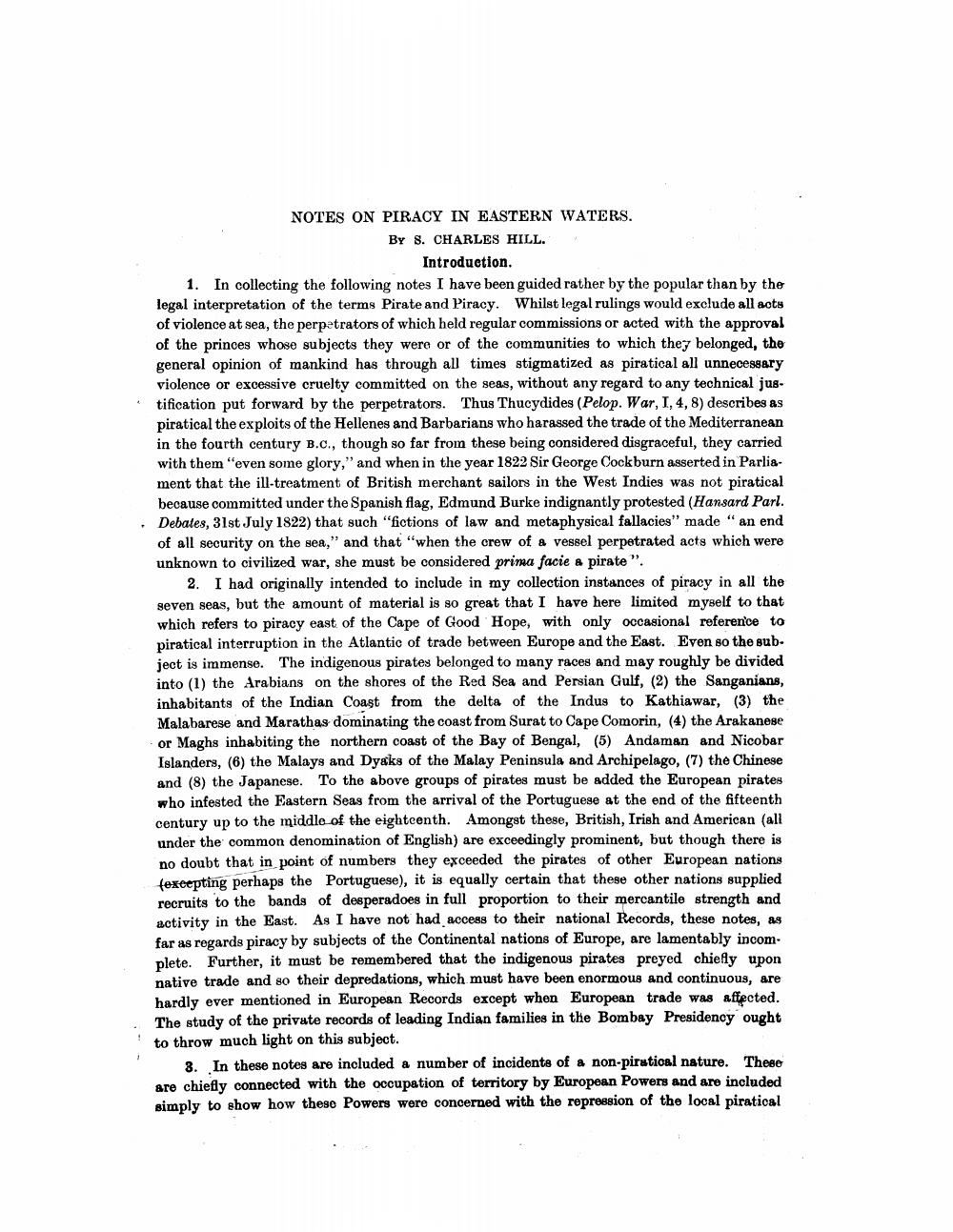________________
NOTES ON PIRACY IN EASTERN WATERS.
By S. CHARLES HILL.
Introduction. 1. In collecting the following notes I have been guided rather by the popular than by the legal interpretation of the terms Pirate and Piracy. Whilst legal rulings would exclude all acts of violence at sea, the perpetrators of which held regular commissions or acted with the approval of the princes whose subjects they were or of the communities to which they belonged, the general opinion of mankind has through all times stigmatized as piratical all unnecessary violence or excessive cruelty committed on the seas, without any regard to any technical justification put forward by the perpetrators. Thus Thucydides (Pelop. War, I, 4, 8) describes as piratical the exploits of the Hellenes and Barbarians who harassed the trade of the Mediterranean in the fourth century B.c., though so far from these being considered disgraceful, they carried with them "even some glory," and when in the year 1822 Sir George Cockburn asserted in Parliament that the ill-treatment of British merchant sailors in the West Indies was not piratical because committed under the Spanish flag, Edmund Burke indignantly protested (Hansard Parl. Debates, 31st July 1822) that such "fictions of law and metaphysical fallacies" made " an end of all security on the sea," and that “when the crew of a vessel perpetrated acts which were unknown to civilized war, she must be considered prima facie a pirate".
2. I had originally intended to include in my collection instances of piracy in all the seven seas, but the amount of material is so great that I have here limited myself to that which refers to piracy east of the Cape of Good Hope, with only occasional reference to piratical interruption in the Atlantic of trade between Europe and the East. Even so the subject is immense. The indigenous pirates belonged to many races and may roughly be divided into (1) the Arabians on the shores of the Red Sea and Persian Gulf, (2) the Sanganians, inhabitants of the Indian Coast from the delta of the Indus to Kathiawar, (3) the Malabarese and Marathas dominating the coast from Surat to Cape Comorin, (4) the Arakanese or Maghs inbabiting the northern coast of the Bay of Bengal, (5) Andaman and Nicobar Islanders, (6) the Malays and Dyaks of the Malay Peninsula and Archipelago, (7) the Chinese and (8) the Japanese. To the above groups of pirates must be added the European pirates who infested the Eastern Seas from the arrival of the Portuguese at the end of the fifteenth century up to the middle of the eighteenth. Amongst these, British, Irish and American (all under the common denomination of English) are exceedingly prominent, but though there is no doubt that in point of numbers they exceeded the pirates of other European nations fexcepting perhaps the Portuguese), it is equally certain that these other nations supplied recruits to the bands of desperadoes in full proportion to their mercantile strength and activity in the East. As I have not had access to their national Records, these notes, as far as regards piracy by subjects of the Continental nations of Europe, are lamentably incomplete. Further, it must be remembered that the indigenous pirates preyed chiefly upon native trade and so their depredations, which must have been enormous and continuous, are hardly ever mentioned in European Records except when European trade was affected. The study of the private records of leading Indian families in the Bombay Presidency ought to throw much light on this subject.
3. In these notes are included a number of incidents of a non-piratioal nature. These are chiefly connected with the occupation of territory by European Powers and are included simply to show how these Powers were concerned with the repression of the local piratical




